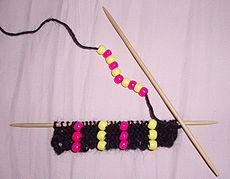
Bead knitting
Encyclopedia

Yarn
Yarn is a long continuous length of interlocked fibres, suitable for use in the production of textiles, sewing, crocheting, knitting, weaving, embroidery and ropemaking. Thread is a type of yarn intended for sewing by hand or machine. Modern manufactured sewing threads may be finished with wax or...
) and (2) the longer wear of the beads may lengthen the life of the knitted fabric significantly.
The techniques are described here for beads, but knitting sequins (and other perforated objects) can be done analogously.
Techniques
There are two main approaches- threading the beads on in advance, and threading the beads on individually as the object is knitted.Threaded on in advance
The classic approach is to thread beads on the yarn in advance. There are several ways to go about knitting the beads in though: slipping the stitch, putting the bead between stitches, and putting the bead on the stitch.The slip stitch method is to slip the stitch with the yarn (and bead) in front
Slip-stitch knitting
Slip-stitch knitting is a family of knitting techniques that use slip stitches to make multiple fabrics simultaneously, to make extra-long stitches, and/or to carry over colors from an earlier row.-Basic methods:...
at the position where a bead is desired. The bead will be visible only on the right side of the work. The disadvantage of this method is that beads cannot be arranged on top of each other, since the same stitch would have to be slipped multiple times. The axis of the bead is horizontal to the work.
Putting the bead between the two stitches is done by positioning the bead on the yarn connecting two stitches, i.e., between two bights. This results in the bead being visible from both sides of the work when beads are slipped on both sides. The bead has a tendency to not lie straight when placed with this method. The axis of the bead is horizontal with respect to the work. This is the method shown in the picture.
The third method is to knit the stitch with the bead on the bight itself. Technically, this is considered "bead knitting" rather than "beaded knitting." For consistency, the bead should be positioned on the same leg of the bight. Using this third method, one can make a densely beaded knitted fabric, i.e., one that appears to be all beads, with no knitted yarns visible. It is sometimes difficult, however, to keep the bead on the right side of the fabric; for this reason, the stitches are often twisted
Plaited stitch (knitting)
In knitting, a plaited stitch is a single knitted stitch that is twisted clockwise or counterclockwise , usually by one half-turn but sometimes by a full turn or more.-Methods:...
, to tighten up the fabric.
Threaded as it is knitted
A second approach that offers more flexibility is to thread the bead onto the bightBight (knot)
In knot tying, a bight is a curved section, slack part, or loop between the two ends of a rope, string, or yarn. The term is also used in a more specific way when describing Turk's head knots, indicating how many repetitions of braiding are made in the circuit of a given knot.-Slipped knot:In order...
, i.e., onto the loop before it is knitted. (The rotational axis of the bead is aligned vertically.) In this case, the beads appears on both sides of the fabric. The chief drawback of this method is that the beads must be larger, since two strands of the yarn pass through the bead. In this approach, it is helpful to make an elongated stitch
Elongated stitch (knitting)
In knitting, an elongated stitch is a stitch that is longer than others. It may be created by wrapping the yarn around the righthand needle two or more times, or by placing yarn overs between stitches and dropping them on the next row.-References:...
to fit both the bead and the next stitch.
A third approach is to sew on the beads after knitting. This approach is the least desirable, since it does not protect the yarn as well and since the sewing thread is usually weaker than the yarn.
History of bead knitting
In the Victorian era, it was popular to knit densely beaded purses using tiny knitting needles made of stiff wire, much smaller (less than 1 mm) than the smallest knitting needleKnitting needle
A knitting needle or knitting pin is a tool in hand-knitting to produce knitted fabrics. They generally have a long shaft and taper at their end, but they are not nearly as sharp as sewing needles. Their purpose is two-fold...
available commercially today. Such tiny stitches allow for very intricate patterns.

